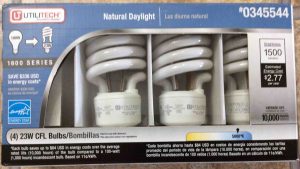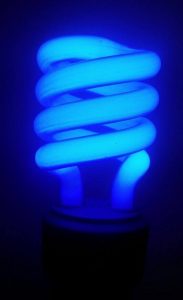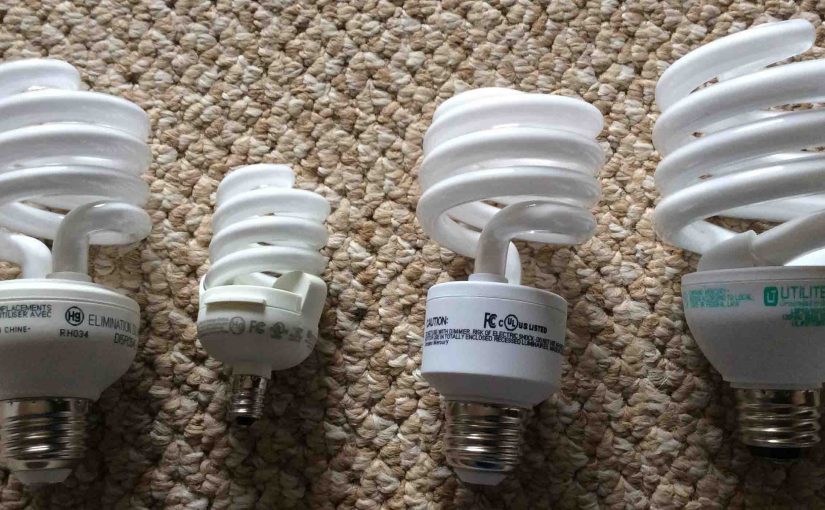While compact fluorescent light technology has been a drastic advance over those very long glass tubes requiring heavy ballasts to operate, this mode of energy saving lighting still suffers from numerous problems, drawbacks, and limitations. We detail some of the most prominent of these compact fluorescent light problems below.

Compact Fluorescent Light Problems, Cons, Drawbacks, and Limitations
Will Become Obsolete Soon, a Big Compact Fluorescent Light Problem !
With the LED light bulbs fast coming up on the technological horizon, it may be unwise to invest heavily right now in compact fluorescent lights. They are indeed more efficient than incandescent lamps. But LED lamps are even more energy-efficient, more rugged, and produce much less heat than their fluorescent ancestors. It appears that compact fluorescent lights, will enjoy limited long-term popularity, as they no longer represent the state-of-the-art of high-efficiency, “green” lighting. So if you’re planning a lighting upgrade to fluorescents, you may want to spend a little extra, and instead, replace your incandescents with LEDs instead.
Compact Fluorescent Lights can Generate Troublesome Radio Frequency Interference (RFI)
Due to the switching nature of the included electronic ballasts, CFLs may interfere with radio reception; particularly on AM broadcast band receivers. So radio buffs should carefully consider the choice to switch to CFLs. Neither incandescent bulbs nor most LED lights generate this RFI / EMI.
Compact Fluorescent Light Problems: CFLs Contain Easily Damaged Electronics
At the base of most any compact fluorescent light is a clump of circuitry that is responsible for illuminating the gas-filled glass tubes above. This electronic ballast contains solid-state components that can be sensitive to voltage spikes arriving on the power line. Lightning storms can create these spikes. In fact, some storms that passed by here overnight took out two of our CFL lamps, and these were plugged into surge protectors as well. Sometimes, the surges can still get through however. Regular incandescent light bulbs are less fragile when subjected to the short-duration pulses of nearby lightning strikes. But CFL lamps are improving noticeably.
Glass is Still Quite Fragile
It still takes only a gentle bump against a wall or drop onto the floor from just a modest height, to shatter the spiral glass tubing that’s found in most compact fluorescent light units. Easy breakage is more of a concern for lights of this type, than it was for incandescent lamps, due to the toxicity of the mercury vapor inside the fluorescent lamps; a gas not used in traditional lamp bulbs. So handle these lights with care; even the spent units.
Another of the Compact Fluorescent Light Problems: They Still Cost a Little More
You can still get an incandescent bulb for under two dollars. But CFL units can cost upwards of three times that much. Yet often, they do not last upwards of three times as long as incandescent lamps. We’ve yet to see any CFL last their advertised seven years. Hopefully, they’ll become cheaper and more reliable in the next couple years. But in the meantime? That $15 we spent for them? Gone! And, the one was only several months old.
Compact Fluorescent Light Problems: Not Dimmable Generally
Traditional light dimming controls that work so well with incandescent lighting, do not work well with many compact fluorescent lamps, unless you buy one that specifically supports dimming. Practically all incandescent light bulbs and most LED light bulbs support traditional leading-edge dimmer switches. Over the past few years though, more “dimmable” fluorescent light bulbs have appeared. But they’re not as cheap as their non dimmable versions.
Fluorescent Lights in General Sometimes Do Not Start in Cold Weather
Particularly in sub-freezing temperatures, a compact fluorescent lamp might not come on, as the mercury vapor gas inside does not as readily conduct electricity when cold. However, both incandescent and LED light globes instantly come on, full brightness, even in the deepest cold snaps. Cold-weather versions are available now, though for a bit more money, that feature circuitry that adjusts the amount of current flow in the arc tube, to compensate for the coldness of the gas inside. It senses the external temperature and when it detects cold environments, the electronic ballast applies more voltage initially, to create more light. Then, as the gas inside grows warmer, and conducts electricity more readily, voltages are reduced to prevent excessive brightness. So, a more uniform brightness level is maintained from the bulb, over a wider range of surrounding temperatures.
Compact Fluorescent Light can Take Several Minutes to Reach Full Brightness
Again, this is especially true when these light bulbs are cold. Neither LEDs nor incandescents exhibit this behavior however, as they light to full brightness immediately. But this is fast becoming a non issue, as advances in electronic ballast control allow for better regulation of bulb brightness. The ones we’ve tested achieve full brightness in less than a minute, when operated in average room temperatures.
They Should Be Recycled
You can’t just throw away burned-out globes, as they are considered hazardous waste. Proper disposal means finding a safe spot to store them until you locate a recycling center or event to turn them in. You can still throw away spent incandescent bulbs in the regular trash however.
Compact Fluorescent Light Problems: These Bulbs are Less Environmentally Safe
Since compact fluorescent light globes should be recycled, and since appropriate recycling stations have not yet been set up in numerous market areas, you should store them until such facilities become available. While in storage, you may accidentally break the bulbs, adding small amounts of mercury vapor to the environment. So, be sure to stow them in a safe, out of the way location until recycling day. Indeed, large-scale compact fluorescent light use raises the risks of mercury contamination in our air. No mercury in either incandescents or LEDs.
Fluorescent Lamps Fail Early when Switched On and Off Too Often
As with the more traditional fluorescent lamps, cycling compact fluorescent ones on and off more often than once in two or three hours, can cause premature bulb failure. So once you turn them on, it’s best to leave them on for at least two hours. Of course, this means that you’ll use somewhat more energy to keep your fluorescent bulbs properly conditioned. LEDs are not at all sensitive to this however, and incandescent lamps are less sensitive to frequent on-off cycling.
Another of the Compact Fluorescent Light Problems: They Often Flicker
Often, we see compact fluorescent lights twinkling and “barber polling” in shops, kitchens, and porches. Even when a this type of bulb has warmed up fully, it still can flicker annoyingly, due to shifting paths of gas ionization inside the tubes as the internal temperature fluctuates. Without extreme care in the design of the electrodes inside the glass, this problem can worsen. Light flickering has been a long-running problem of fluorescent light technology, that has virtually never plagued incandescent lights or LEDs.
Compact Fluorescent Lights Currently Mean Fewer Domestic Manufacturing Jobs
With the bulk of these lamps manufactured in China, and incandescent bulbs being made at home, the switch to compact fluorescent means fewer light bulb manufacturing positions here in the US.

But in spite of this world of problems with the compact fluorescent light, our energy-savings strategy has, and will continue to incorporate SOME compacts around the house here. But we will not replace ALL incandescent bulbs with CFLs; particularly the outside lights. We’re still waiting for the LED lights to cheapen and increase in light output to match fluorescent output. At that time, upgrades of all lights to LEDs will commence.
Related Posts to Compact Fluorescent Light Problems
- CFL Advantages and Disadvantages
- LED Light Bulb Picture Gallery
- Review: CREE™ A19 BA19 60w LED Soft White 2700k Dimmable Light Bulb for Indoor or Outdoor Use
- Philips LED A19 100w Daylight Light Bulb Review
- Solving Noisy Window Air Conditioner Vibration Problems, How To
- Ecosmart™ LED 60w A19 Daylight White Light Bulb Review
References for Compact Fluorescent Light Problems
Revision History
-
- 2019-04-14: Added tags.
- 2018-02-02: Originally published.
